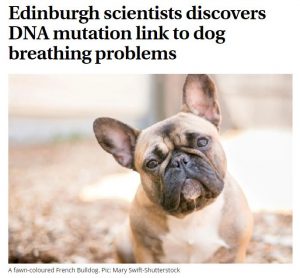Have we made a breakthrough on breathing problems in dogs?
A recent scientific paper* from The University of Edinburgh is being reported to have found the genetic basis for breathing problems in dogs. And it’s attracted lots of media attention as well as lively discussion from dog owners across the world. On first glance, it claims to have found the DNA mutation linked to breathing problems in dogs. But the snappy headlines the media reported regarding this discovery aren’t all they’re cracked up to be.
Breathing problems in dogs have been a hot topic in the pet owner, dog breeder, veterinary and animal welfare community for some time now, generating fierce debate and a fair amount of hostility between different stakeholders. The main contention is that we’ve gone too far breeding for extreme anatomy and appearance of the brachycephalic or flat faced breeds, most notably Pugs, French Bulldogs and English Bulldogs. These three breeds are not only the most severely affected by health problems associated with their extreme anatomy, but also some of the most popular in recent years.
(*https://journals.plos.org/plosgenetics/article?id=10.1371/journal.pgen.1008102)


So what does this new paper actually report?
The Edinburgh paper reports a breakthrough genetic discovery of a gene responsible for breathing issues in Norwich Terriers, a breed that suffers from a condition called upper airway syndrome (UAS), some of the symptoms of which overlap with BOAS. Disruption to this gene, ADAMTS3, causes swelling and fluid accumulation or oedema in the tissues of the throat and upper airway which in turn causes obstruction. It’s a serious risk during recovery from general anaesthesia in Norwich Terriers, which is why finding the gene responsible is so important to the veterinary profession, anyone interested in Norwich Terriers, and indeed dog welfare.
The interesting thing about Norwich Terriers is that they are not brachycephalic or truly flat faced breeds. Rather they are mesocephalic having a short, but not flat, face. The paper alludes to the overlap that some of the brachycephalic breeds may also be affected by the mutation in ADAMTS3, and this may partially contribute to anaesthetic recovery complications in these breeds too. But the overriding and most impactful feature of these breeds that causes obstructive airway disease is their brachycephalic skull shape. Being complicated by also having this genetic mutation means some individuals will be even higher risk for post anaesthesia complications.
What’s been reported in the media?
Unfortunately, the interpretation of what the Edinburgh paper actually reports and its implications for brachycephalic welfare, a hot topic right now, has been misguided or unclear in many circumstances. Rather than focusing on Norwich Terriers, several news articles have featured a brachy breed image with a sensationalist headline. Public confusion has ensued. Defensive brachy breeders have jumped to the assertion that it’s actually not the flat faces of their breed they so love and adore that cause breathing problems. Could it be this gene that is causing the problem?
Why are people arguing about this online?
Due to the confusing headlines, and most people not reading what the scientific report actually says, many have made false assumptions about the meaning of the discovery. Frequently jumping on the claim or belief that maybe the flat facial features of their favourite breeds are not the main issue, but instead it’s this newly discovered gene responsible. Vets and animal welfare experts have been quick to point out it’s actually the structure and anatomy of these breeds that cause them most issues when it comes to breathing problems.
The key information everyone perhaps should keep in mind comes from a previous paper on Norwich Terriers : “Norwich Terriers suffer from an upper airway obstructive syndrome that differs from that encountered in brachycephalic breeds. Affected dogs are difficult to identify without laryngoscopic examination because of the lack of clinical signs and abnormalities in physical examination findings, despite severe airway obstruction. Care is warranted when anesthetizing Norwich Terriers because of the small size of the laryngeal opening.” https://onlinelibrary.wiley.com/doi/pdf/10.1111/jvim.12206.
So what does the future hold?
The main and most effective way to improve breathing in brachycephalic breeds is still going to to selecting for better facial, head and airway conformation than gene therapy for a limited number of brachy dogs with this genetic issue in conjunction with extreme conformation. For Norwich Terriers and those individual brachy dogs with the ADAMTS3 mutation maybe they’ll also benefit from this research and gene therapy in future, but let’s not ignore the real issue staring us in the (flat) face. Let’s focus more on breeding to breathe.
Related article: How brands can tackle the brachycephalic dog breed dilemma


I have a nine year old rescue pug/ Pomeranian . Because of this mix of breeding will his breathing become more strained as he gets older. At the moment he is on steroids for a runny ear, but these to seem to be making his breathing worse, if I stop them , how quickly can idothis please
Hi John,
These are questions that your vet can help you with.
Kind regards,
Sophie
I am beating my cockadoodle whilst taking a shipoo.